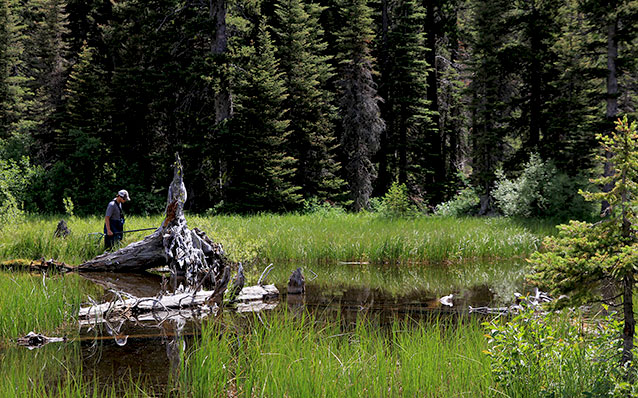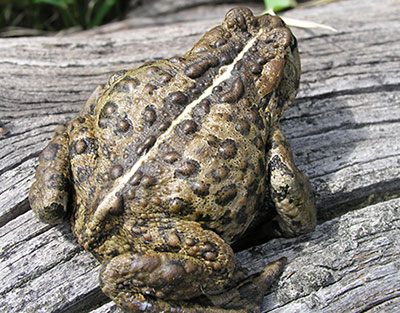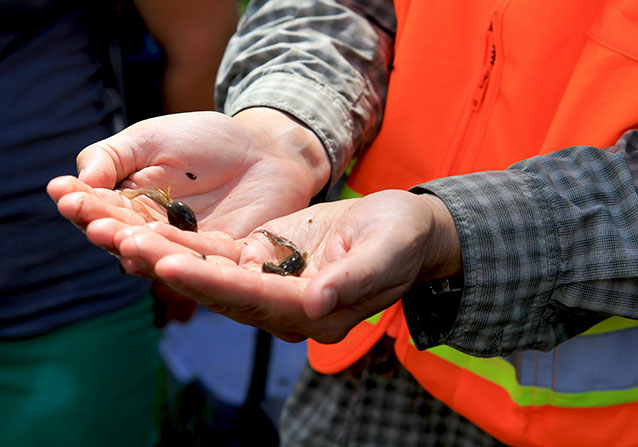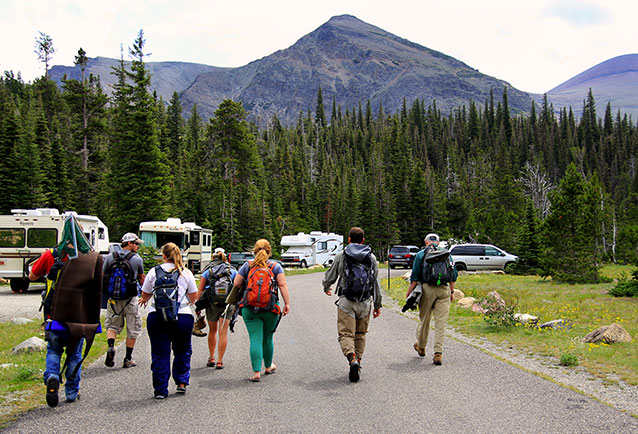
NPS/Jim Giese
Distant rumbles of thunder creep closer as Blake Hossack, a research zoologist with the U.S. Geological Survey (USGS), finishes inserting a microchip in the back of an adult boreal toad. Standing calf-deep in water, a nervous student looks west toward the thunder, and I imagine she is contemplating the wisdom of her current situation. She and other students from the Flathead Lake Biological Station have come to Glacier’s Two Medicine area to learn about amphibians in the park. I joined them to learn about the status of amphibians and the role climate change may have on these cold-blooded creatures. I soon discover there is a lot to consider when dealing with amphibians.
Our main target is the boreal toad, but Hossack also expects we may catch Columbia spotted frogs and perhaps long-toed salamanders. Boreal toads are one of six species of amphibians known in Glacier, and are the only toad found in the park.
Besides being effective controllers of many insect “pests,” amphibians are a food source for many mammals, birds, and fish. They are also regarded as excellent ecological indicators due to high sensitivity to slight changes in their environment. A decline or extinction of a population could represent responses to habitat fragmentation, ecosystem stress, disease, pollution from chemical inputs, or other human-caused activities.
Monitoring of amphibians in Glacier began in 2000, as part of the USGS’s Amphibian Research and Monitoring Initiative (ARMI). Worldwide declines in amphibian populations prompted the creation of ARMI, a national effort to document trends of amphibian populations on federal lands and to conduct research on the causes of amphibian declines and malformations. Information collected by ARMI is then used by resource managers to protect amphibian populations.

Microchips, which contain unique identifying codes, are inserted into amphibians monitored in the study in order to estimate population size and individual survival rates. Estimating amphibian occupancy, or the probability that suitable habitat contains breeding populations, is done by collecting larval and adult amphibians using dip nets. A decline in occupancy could indicate a reduction in suitable habitat, a decrease in population, or a response to changes in climate. In Glacier, the boreal toad’s occupancy rate is roughly 6% of the suitable monitored sites, whereas the Columbia spotted frog has a higher occupancy rate of approximately 20–25%. Overall, the occupancy rate has remained steady during the study, although there have been shifts in which wetlands are being occupied.
As we gather gear and head into the cool, murky waters of the survey site, Hossack tells me that boreal toads were once common in this particular wetland. However, he and his staff are not finding toads in anywhere near the numbers they have in past years. In fact, he has instructed his crew to stop surveying for amphibians here. “It is one of those dilemmas: the smaller a population gets, the more time you need to devote to it. Yet at the same time, the amount of effort [required to collect such a small amount of data] is so high you eventually have to say, well, with a limited budget, you are better off doing something else.”
Listed as a Species of Concern by the State of Montana, boreal toads were once more abundant in western Montana, as well as in other states throughout its range. The reason for their decline is uncertain, but disease, fragmentation and loss of habitat, and climate change are thought to be contributing factors.
During the drive to the Two Medicine area, I asked Hossack about climate change and its possible effects on amphibians in the park. He mentioned a recent study in which he researched how populations of the Rocky Mountain tailed frog, a frog found in cold streams of Glacier, might respond to long-term effects of climate change.
In previous studies, the consequence of a warming climate on a species with a specific temperature-range tolerance has been applied only to larger geographic areas. Hossack and his colleagues wondered if the same consequences could hold true for populations of the same species on a much smaller, localized geographic scale. They compared the survival rates of six different populations of Rocky Mountain tailed tadpole in Glacier to variations in late-summer temperatures. The results showed that the ability of individual populations to tolerate warming temperatures can indeed vary across a small geographic scale and is linked to the increased complexity of the local environment.
Additional questions need to be explored, such as how the frogs respond during different life stages and what role genetics may play. However, once these factors are identified, this information may lead to additional tools for resource managers in response to a warming climate. For example, there may be greater value in protecting populations of frogs known to tolerate a wider range of temperatures, as they might repopulate areas once inhabited by other, less-adaptable frog populations.
Back in the wetland, Hossack sweeps a dip net through the shallow water to collect larval forms of amphibians. Students follow his example and soon numerous tadpoles at differing stages of metamorphosis are collected in blue tote boxes.
Hossack pulls a Columbia spotted frog larva from the tote. About two inches long, the tadpole has a brownish-green coloring on its back and gold flecking scattered along the belly. A boreal toad tadpole is next, much smaller, less developed, and nearly jet black. Hossack explains that boreal toads breed later than Columbia spotted frogs. This prompts me to ask about the life cycle of boreal toads, since it is thought that some correlation exists between timing of breeding and success rate.

NPS/Jim Giese
Hossack explains that adult boreal toads emerge in spring once snowmelt has cleared away from their burrows and daily temperatures remain above freezing. The timing of breeding depends on snowmelt and begins as early as May in lower elevations, but can be delayed to July or early August in higher elevations. Depending on a female’s body condition, breeding may occur every 1–3 years. Eggs are deposited in long strings which are normally laid in shallow water. Development of egg and larva are temperature-dependent and development from hatching to metamorphosis can take up to 75 days in higher elevations. It is this temperature-dependency that might be affected by a changing climate and is one of the reasons Hossack is monitoring breeding populations.
A new concern for amphibians in Glacier, and one that Hossack is also monitoring, is the emergence of amphibian chytridiomycosis, otherwise known as chytrid. Chytrid is an infection of skin cells in amphibians, caused by the microscopic aquatic fungus, Batrachochytrium dendrobatidis (Bd). It is linked to widespread declines in amphibian populations throughout the world. Chytrid was first discovered in a boreal toad in Glacier’s Two Medicine area in 2001. It is now detected in 30–50% of the wetlands sampled each year.
Although present, Hossack says chytrid does not appear to be causing problems within the park: “While it’s infecting animals in our area, it does not seem to be causing population crashes. However, we can’t rule out a link to slow declines, because that is much harder to tease apart from other sources of decline.” In fact, all of his monitoring efforts are geared toward determining the cause of reduced amphibian populations, and, in particular for Glacier, the boreal toad. At this point, the reasons for the declines remain unclear, but Hossack is hopeful that this and other monitoring sites throughout Montana and the West will shed light on this worldwide phenomenon.
The thunder and heavy, dark skies now engulf us as Hossack finishes the final measurements of the last caught toad. The consideration of heading to another wetland is trumped as rain starts to pelt the surface of the wetland and raingear is pulled out of packs.
Our trek out of the soggy wetland in the now cold, steady rain does not dampen the enthusiasm of the students. The group discusses the toads and frogs seen today and the important role they play in a healthy ecosystem. The highlight of the field trip, though, seems to be the constant chirping by a male toad. One student from Kentucky, who is experiencing Glacier for the first time, wonders if he will ever get a chance to hear the toad’s chirping again, referring, I assume, to whether he will return to Glacier. My hope is that he will get that chance—both to return to the park, and to hear the toads chirping when he does.

NPS/Jim Giese
Downloadable pdf
Last updated: October 14, 2024
